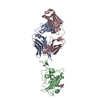+Search query
-Structure paper
| Title | Engineering SARS-CoV-2 specific cocktail antibodies into a bispecific format improves neutralizing potency and breadth. |
|---|---|
| Journal, issue, pages | Nat Commun, Vol. 13, Issue 1, Page 5552, Year 2022 |
| Publish date | Sep 22, 2022 |
 Authors Authors | Zhiqiang Ku / Xuping Xie / Jianqing Lin / Peng Gao / Bin Wu / Abbas El Sahili / Hang Su / Yang Liu / Xiaohua Ye / Eddie Yongjun Tan / Xin Li / Xuejun Fan / Boon Chong Goh / Wei Xiong / Hannah Boyd / Antonio E Muruato / Hui Deng / Hongjie Xia / Jing Zou / Birte K Kalveram / Vineet D Menachery / Ningyan Zhang / Julien Lescar / Pei-Yong Shi / Zhiqiang An /    |
| PubMed Abstract | One major limitation of neutralizing antibody-based COVID-19 therapy is the requirement of costly cocktails to reduce emergence of antibody resistance. Here we engineer two bispecific antibodies ...One major limitation of neutralizing antibody-based COVID-19 therapy is the requirement of costly cocktails to reduce emergence of antibody resistance. Here we engineer two bispecific antibodies (bsAbs) using distinct designs and compared them with parental antibodies and their cocktail. Single molecules of both bsAbs block the two epitopes targeted by parental antibodies on the receptor-binding domain (RBD). However, bsAb with the IgG-(scFv) design (14-H-06) but not the CrossMAb design (14-crs-06) shows increased antigen-binding and virus-neutralizing activities against multiple SARS-CoV-2 variants as well as increased breadth of neutralizing activity compared to the cocktail. X-ray crystallography and cryo-EM reveal distinct binding models for individual cocktail antibodies, and computational simulations suggest higher inter-spike crosslinking potentials by 14-H-06 than 14-crs-06. In mouse models of infections by SARS-CoV-2 and multiple variants, 14-H-06 exhibits higher or equivalent therapeutic efficacy than the cocktail. Rationally engineered bsAbs represent a cost-effective alternative to antibody cocktails and a promising strategy to improve potency and breadth. |
 External links External links |  Nat Commun / Nat Commun /  PubMed:36138032 / PubMed:36138032 /  PubMed Central PubMed Central |
| Methods | EM (single particle) / X-ray diffraction |
| Resolution | 2.46 - 7.3 Å |
| Structure data | EMDB-33506, PDB-7xxl:  PDB-7wph:  PDB-7wpv: |
| Chemicals |  ChemComp-NAG:  ChemComp-HOH: |
| Source |
|
 Keywords Keywords | VIRAL PROTEIN/IMMUNE SYSTEM / SARS-Cov2 RBD / antibody / PROTEIN BINDING / VIRAL PROTEIN-IMMUNE SYSTEM complex / IMMUNE SYSTEM / SARS-Cov2 RBD neutralising antibody / IMMUNE SYSTEM/VIRAL PROTEIN / Complex / RBD / Fab / IMMUNE SYSTEM-VIRAL PROTEIN complex |
 Movie
Movie Controller
Controller Structure viewers
Structure viewers About Yorodumi Papers
About Yorodumi Papers






 homo sapiens (human)
homo sapiens (human)